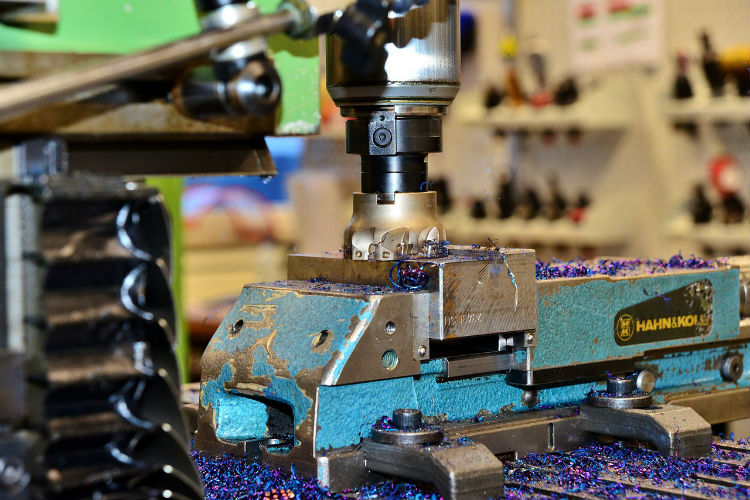
Additive and subtractive manufacturing aren’t new concepts. Additive manufacturing is just another name for 3D printing — creating something new by adding one layer of a material at a time. Subtractive manufacturing is just a fancy name for milling — removing or subtracting layers to form a finished product.
A new style of production is beginning to emerge — hybrid manufacturing — which combines both additive and subtractive techniques. It’s been getting a lot of attention recently, but is hybrid manufacturing worth all the hype?
How Does Hybrid Manufacturing Work?
How can you combine 3D printing and milling technologies to create a functional hybrid? In one case, it involves metal powder and high-temperature lasers. The powder is layered on in specific locations by a 3D printer, then melted and sintered by the laser. At the same time, the piece is milled by high-speed blades that shape the newly placed metal into a finished product.
The hybrid aspect comes in the form of the machinery itself. Both additive and subtractive processes are integrated into a single piece of equipment.
Why the Hype?
For something that is just combining two existing technologies, why is there so much hype surrounding hybrid manufacturing?
For many industries, this could potentially streamline the production process. Instead of 3D printing something and transferring it to a different piece of equipment to be machined, the entire operation could take place in a single machine. This process reduces the time needed to produce each piece because you can kill two birds with one stone.
As the process improves, it could eliminate even more downstream production steps. Imagine being able to form, mill and polish all inside the same piece of equipment. Instead of moving a product from one machine to the next, you could reduce production time and improve efficiency by investing in a single piece of equipment that produces a product that is finished and ready to ship. Companies could potentially fit their entire production chain in a single room, eliminating the need for large, costly warehouses.
Is It Worth The Hype?
Is this new hybrid manufacturing trend worth the hype?
For companies that use a combination of 3D printing and milling, the answer is a resounding yes. Increasing efficiency can lower costs and improve the quality of the product. Eliminating traditional subtractive machines can also reduce the amount of waste the facility produces. Traditional subtractive devices create a lot of waste that has to be disposed of because it is often impossible to recycle. Additive manufacturing only uses the exact amount of material needed to produce a piece, creating almost no waste.
Over time, this technology could reduce in-house repair and maintenance costs, improving the company’s profit margin. Having a machine on-site that can fabricate, mill and polish a piece so it’s ready for shipment essentially eliminates the need for multiple pieces of equipment that do each part of the job.
Additive manufacturing is still in its infancy, but by pairing it with existing subtractive manufacturing techniques, innovative engineers have created an entirely new way to utilize this new technology. How can companies prepare to adopt hybrid manufacturing in their supply chains?
Adopting Hybrid Manufacturing
What can a manufacturing company do to streamline the process of adopting these new technologies?
When it comes down to it, any company that has added new technology to its supply chain in the last decade — from five-axis machining to automated workholding — is already well equipped to add a new type of technology. Hybrid manufacturing isn’t something you will need an entirely new degree to understand. Instead, it’s merely integrating two existing technologies to use the strengths of each, making a better-functioning final product.
That said, training will be necessary to understand the ins and outs of the new equipment. Ongoing technical training can be beneficial, making it easier for crew members who usually work their way across multiple machines to finish one piece to adopt this new equipment.
Large-scale manufacturing projects are still adapting additive manufacturing technologies. Hybrid technologies are also continuing to grow and change as they continue to advance. The next step, before these hybrid manufacturing machines are ready for mass production, is to increase their speed and enable programmers to input more complex functions into their software. Eventually, these hybrid machines will shrink the production process for a variety of different products down into one piece of equipment.
Hybrid technologies could be a game-changer for the manufacturing industry. By taking additive and subtractive equipment and integrating them into a single machine, this equipment could potentially eliminate the need for multistage manufacturing. It could also reduce manufacturing waste, making this industry more eco-friendly. That’s something that is quickly becoming essential, as consumers are refusing to purchase products that are produced without taking the company’s environmental impact into account.
Is hybrid technology worth the hype? Yes, but the hype might be a bit early. This technology is still in its beginning stages. While it is no longer a concept trapped in a computer or the mind of an engineer, it isn’t quite ready for mass production. Once it is, though, it could potentially turn the manufacturing industry on its ear. We’ll have to wait and see what happens with this manufacturing method in the coming years. Once it’s ready to be mass produced and adopted by manufacturers around the world, we could see enormous changes in product quantity and quality on the horizon.











